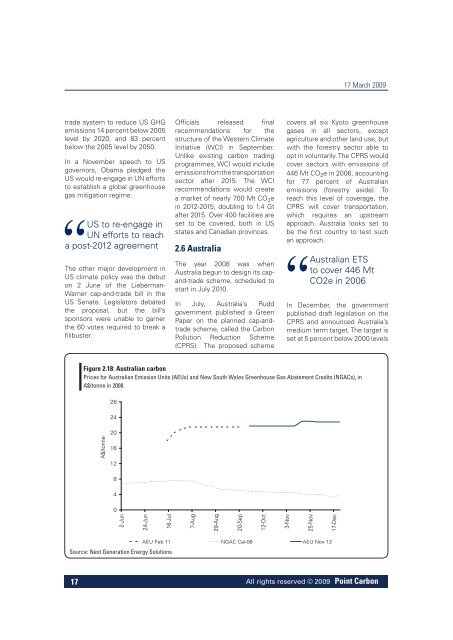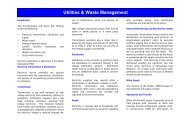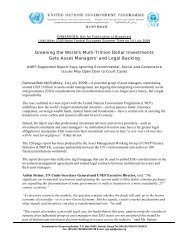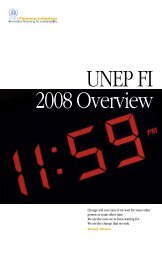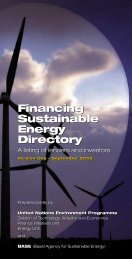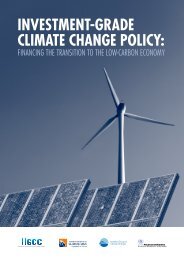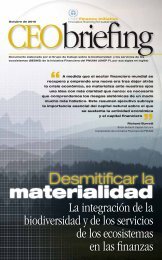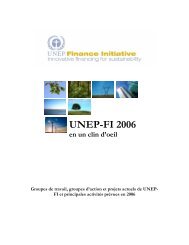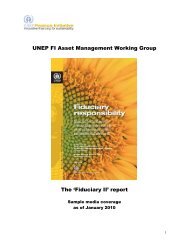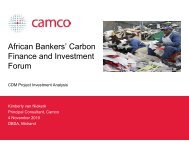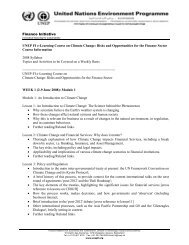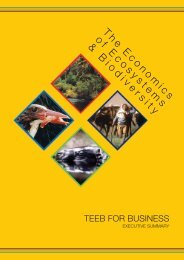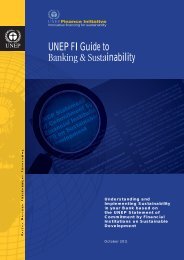Carbon 2009 Emission trading coming home - UNEP Finance Initiative
Carbon 2009 Emission trading coming home - UNEP Finance Initiative
Carbon 2009 Emission trading coming home - UNEP Finance Initiative
Create successful ePaper yourself
Turn your PDF publications into a flip-book with our unique Google optimized e-Paper software.
17 March <strong>2009</strong><br />
trade system to reduce US GHG<br />
emissions 14 percent below 2005<br />
level by 2020, and 83 percent<br />
below the 2005 level by 2050.<br />
In a November speech to US<br />
governors, Obama pledged the<br />
US would re-engage in UN efforts<br />
to establish a global greenhouse<br />
gas mitigation regime.<br />
US to re-engage in<br />
UN efforts to reach<br />
a post-2012 agreement<br />
The other major development in<br />
US climate policy was the debut<br />
on 2 June of the Lieberman-<br />
Warner cap-and-trade bill in the<br />
US Senate. Legislators debated<br />
the proposal, but the bill’s<br />
sponsors were unable to garner<br />
the 60 votes required to break a<br />
filibuster.<br />
Officials released final<br />
recommendations for the<br />
structure of the Western Climate<br />
<strong>Initiative</strong> (WCI) in September.<br />
Unlike existing carbon <strong>trading</strong><br />
programmes, WCI would include<br />
emissions from the transportation<br />
sector after 2015. The WCI<br />
recommendations would create<br />
a market of nearly 700 Mt CO 2 e<br />
in 2012-2015, doubling to 1.4 Gt<br />
after 2015. Over 400 facilities are<br />
set to be covered, both in US<br />
states and Canadian provinces.<br />
2.6 Australia<br />
The year 2008 was when<br />
Australia begun to design its capand-trade<br />
scheme, scheduled to<br />
start in July 2010.<br />
In July, Australia’s Rudd<br />
government published a Green<br />
Paper on the planned cap-andtrade<br />
scheme, called the <strong>Carbon</strong><br />
Pollution Reduction Scheme<br />
(CPRS). The proposed scheme<br />
covers all six Kyoto greenhouse<br />
gases in all sectors, except<br />
agriculture and other land use, but<br />
with the forestry sector able to<br />
opt in voluntarily. The CPRS would<br />
cover sectors with emissions of<br />
446 Mt CO 2 e in 2006, accounting<br />
for 77 percent of Australian<br />
emissions (forestry aside). To<br />
reach this level of coverage, the<br />
CPRS will cover transportation,<br />
which requires an upstream<br />
approach. Australia looks set to<br />
be the first country to test such<br />
an approach.<br />
Australian ETS<br />
to cover 446 Mt<br />
CO2e in 2006<br />
In December, the government<br />
published draft legislation on the<br />
CPRS and announced Australia’s<br />
medium term target. The target is<br />
set at 5 percent below 2000 levels<br />
Figure 2.18: Australian carbon<br />
Prices for Australian <strong>Emission</strong> Units (AEUs) and New South Wales Greenhouse Gas Abatement Credits (NGACs), in<br />
A$/tonne in 2008.<br />
28<br />
24<br />
20<br />
16<br />
12<br />
8<br />
4<br />
0<br />
2-Jun<br />
24-Jun<br />
16-Jul<br />
7-Aug<br />
A$/tonne<br />
29-Aug<br />
20-Sep<br />
12-Oct<br />
3-Nov<br />
25-Nov<br />
17-Dec<br />
Source: Next Generation Energy Solutions<br />
AEU Feb 11 NGAC Cal-08 AEU Nov 12<br />
17<br />
All rights reserved © <strong>2009</strong> Point <strong>Carbon</strong>


